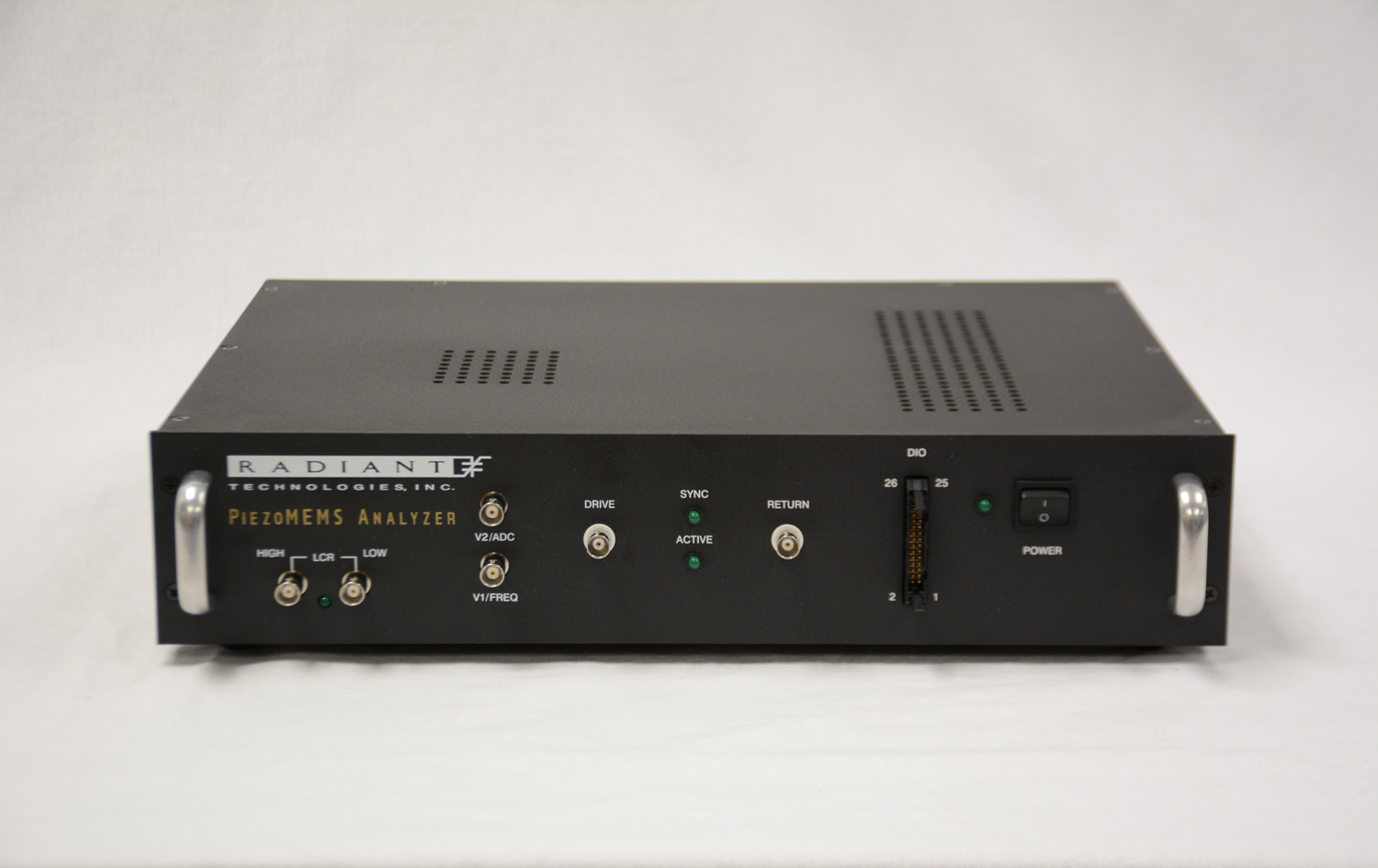Leaving the Laboratory
Thin-piezoelectric-film technology is leaving the laboratory to become commercial PiezoMEMS Analyzer. Much thicker bulk capacitors are being embedded as actuators and sensors inside their own electronic circuitry. Multidisciplinary teams of mechanical, electrical, and reliability engineers now work alongside materials engineers to create new and novel devices.

Classic engineering tools such as impulse response, impedance analysis, and resonance characterization must be integrated with traditional polarization, piezoelectric, pyroelectric, and magnetoelectric measurements. To control circuits containing embedded ferroic capacitors, asynchronous or semi-synchronous digital and analog functions must run independent-of or in-parallel-with crystal-clock-controlled ferroic measurements. Communication with embedded controllers and custom digital circuitry is critical. Together these requirements demand an extremely complex test environment.
Radiant Technologies’ Precision PiezoMEMS Analyzer integrates digital, analog, and communications circuit functions with the existing non-linear materials measurement capabilities of the Precision Multiferroic Non-linear Materials Tester, all supervised by Radiant’s Vision programmable test environment. The PiezoMEMS Analyzer not only measures piezoelectric properties of actuator and sensor elements of a commercial product, it will communicate with the product’s electronic logic, talk to embedded microprocessors, supply asynchronous voltages and pulses, and measure sensor frequencies.
Combines Capabilities
Tester Accessories
Tester accessories specifically used for the PeizoMEMS Analyzer
Specifications
Frequency Range: 10 khz
Output Range +/-100V or +/-200V
expandable to 10kV
- 16-bit Arbitrary Waveform Generator output
- 270KHz @ +/-100V and 100KHz @+/-200V built-in
- Accuracy 0.5% or Better
- Maximum Data Points 32000
- Minimum Pulse Widths down to 0.5µs
- Maximum Pulse Widths down to 1µs and up to 1s
- Vision controlled output ramp for maximum accuracy
Polarization Measurement under AC & DC Magnetic Fields
- 18-bit Resolution (analog to digital converters)
- 0.5µs capture rate with 0.1µs interlace facility
- Polarization, output voltage and SENSORs captured simultaneously
- Minimum charge sensitivity -> 0.80fCMinimum PZT capacitor area -> 0.5u2
- Maximum Area Resolution 52.6mC
- Maximum Area Resolution >130cm2 w/o HVI attached)
- Maximum hysteresis loop frequency ->270KHz
- Minimum hysteresis loop frequency -> 1/30th Hz
Vision Data Acquisition & Management System Software Included
Vision dramatically increases the productivity of the researcher, reducing the time required to acquire data in an experiment. Vision’s enhanced productivity directly reduces cost of test. Vision dramatically increases the complexity of the research that may be accomplished by allowing researchers to combine different measurement tasks with environmental controls into an automated test procedure managed by programmable logic embedded with automated data collection, analysis and plotting tools.
Materials Testers running under the Vision Materials RDP Operating System reduces Cost of Test by a factor greater than 10 over any other ferroelectric tester.
Radiant’s Precision Line of Test Systems are driven by Vision Software. Vision is a revolutionary software package that provides exceptional freedom to design, conduct, and review all procedures associated with any material experiment. The Vision test environment will collect all data acquired in a test sequence and organize it in archived data structures along with the test sequence definitions and data analysis tools. The experiment can always be recalled or reproduced. Data and test conditions can be shared over the Internet to allow collaborative research.
Measurements include, but are not limited to - Hysteresis, Leakage, Charge, Retain, Resist, I/V, Fatigue, C(V), PUND, Imprint, Leakage Current, Remnant Hysteresis, Small signal CV, imprint, retention, and piezoelectric displacement from one hardware configuration. Radiant offers optional Piezoelectric, Magnetoelectric, Transistor, and Pyroelectric software programs
